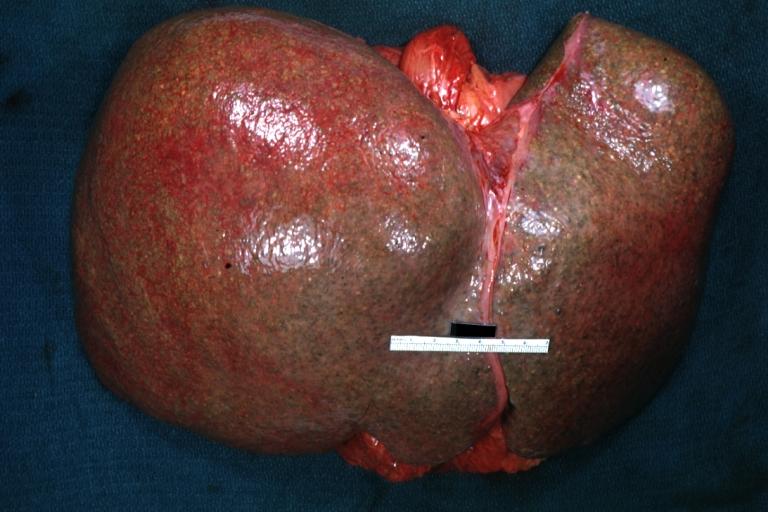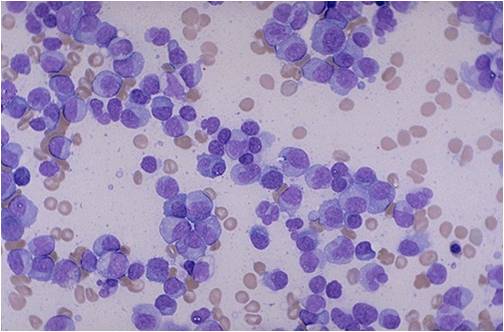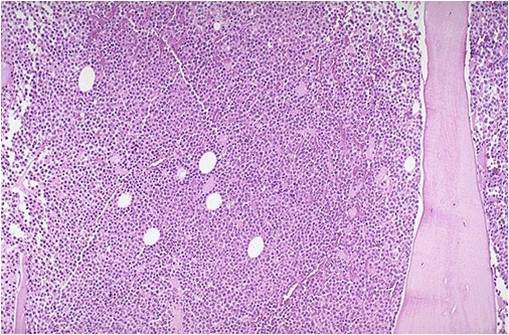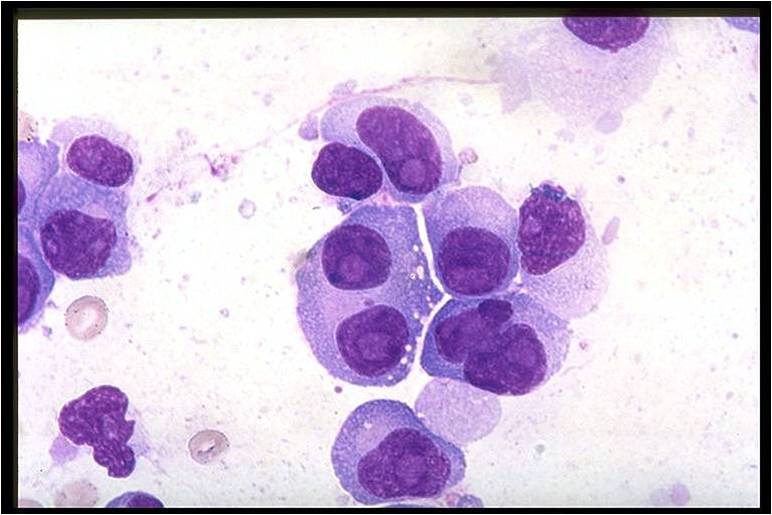POEMS syndrome pathophysiology
|
POEMS syndrome Microchapters |
|
Diagnosis |
|---|
|
Treatment |
|
Case Studies |
|
POEMS syndrome pathophysiology On the Web |
|
American Roentgen Ray Society Images of POEMS syndrome pathophysiology |
|
Risk calculators and risk factors for POEMS syndrome pathophysiology |
Editor-In-Chief: C. Michael Gibson, M.S., M.D. [1] Associate Editor(s)-in-Chief: Syed Hassan A. Kazmi BSc, MD [2]
Overview
POEMS syndrome is an acronym, where the 'P' stands for polyneuropathy, 'O' for organomegaly (specifically of the liver and spleen), 'E' for endocrinopathy, 'M' for immunoglobulin (para-protein or M-protein) and 'S' for skin changes. POEMS syndrome is a para-neoplastic syndrome characterized by multi-organ system dysfunction, monoclonal plasma cell proliferation and demyelinating inflammatory polyneuropathy. The lambda component of immunoglobulin light chains is thought to be overproduced in POEMS syndrome secondary to monoclonal plasma cell proliferation. Bone marrow studies of patients suffering from POEMS syndrome shows lymphoid aggregates rimmed by monotypic or polytypic plasma cells. The monoclonal gammopathy or overproduction of lambda light chain stimulates the monocyte/macrophage system to produce various proinflammatory cytokines. such as interleukin-1, interleukin-6, interleukin-12, vascular endothelial growth factor (VEGF) and TNF-Alpha. Transforming growth factor beta (TGF-beta), an inhbitory cytokine is thought to be underproduced in patients suffering from POEMS syndrome leading to a storm of proinflammatory cytokines which drive the disease process. The overproduction of this IL-6 may be related to some of the clinical features seen in POEMS syndrome such as gammopathy, elevated C-Reactive protein (CRP) and thrombocytosis. The mesangial proliferation and membranoproliferative glomerulonephritis (MPGN) seen in POEMS syndrome is thought to be secondary to increased production of platelet-derived growth factor (PDGF) and fibroblast growth factor beta (FGF-β) have been implicated in mesangial cell proliferation. The neovascularization induced by VEGF leads to increased vascular permeability. Since the increased production of VEGF is unchecked due to the plasma cell dyscrasia, the consequence is an unregulated extravasation of intravascular fluid into the extravascular compartment. resulting in edema. POEMS syndrome is known to be associated multiple myeloma (osteosclerotic type), Castleman's disease, plasmacytoma, monoclonal gammopathy of undetermined significance (MGUS), pulmonary hypertension, restrictive lung disease, thrombophilia, cardiac amyloidosis and papilledema.
Pathophysiology
POEMS syndrome is an acronym, where the 'P' stands for polyneuropathy, 'O' for organomegaly, 'E' for endocrinopathy, 'M' for immunoglobulin (para-protein or M-protein) and 'S' for skin changes. POEMS syndrome is a para-neoplastic syndrome characterized by multi-organ system dysfunction, monoclonal plasma cell proliferation and demyelinating inflammatory polyneuropathy.[1]
Pathogenesis
Monoclonal Plasma Cell Proliferation
- POEMS syndrome is associated with plasma cell dyscrasia in which there is monoclonal proliferation of plasma cells. The plasma cells are involved in antibody production under physiological conditions via reorganization of immunoglobulin heavy and light chains.
- The lambda component of immunoglobulin light chains is thought to be overproduced in POEMS syndrome secondary to monoclonal plasma cell proliferation.[2]
- Bone marrow studies of patients suffering from POEMS syndrome shows lymphoid aggregates rimmed by monotypic or polytypic plasma cells.
- Diffuse infiltration of light chain restricted plasma cells leads to development of predominantly sclerotic bone lesions. This is in contrast with myeloma patients where there is a predominance of lytic bone lesions. The bony lesions are primarily restricted to the axial and proximal appendicular skeleton.[3][4][5]
- The monoclonal gammopathy or overproduction of lambda light chain stimulates the monocyte/macrophage system to produce various proinflammatory cytokines.
Cytokine Storm
- The monoclonal plasma cell proliferation in POEMS syndrome is thought to play a major role in overproduction of numerous pro-angiogenic and pro-inflammatory cytokines.
- The hypercytokinetic state induced in patients of POEMS syndrome is thought to drive the disease process. The following cytokines are overproduced:[6]
Role of Interleukin-6 , Interleukin-12 and TNF-Alpha
- Interleukin- 6 is overproduced in patients with POEMS syndrome. IL-6 is a pro-inflammatory cytokine involved in maturation of B-cells into antibody producing plasma cells, induction of acute phase reactants and thrombopoeisis.[11][12][13] The overproduction of this cytokine may be related to some of the clinical features seen in POEMS syndrome such as gammopathy, elevated C-Reactive protein (CRP) and thrombocytosis.[14][15]
- Interleukin-1 beta and interleukin-6 both are also involved in increased production of VEGF in POEMS syndrome.[16]
Upregulation of VEGF production
- VEGF is a pro-angiogenic cytokine that promotes neovascularization. It is thought to be overproduced in POEMS syndrome and can serve as a marker of disease activity in these patients.
- VEGF is expressed by osteoblasts, chondrocytes, macrophages, tumor cells (including plasma cells) and megakaryocytes.
- VEGF165 is the isoform of VEGF that is overexpressed in POEMS syndrome.
- Increased VEGF could account for the organomegaly, edema, skin hemangiomata, and possibly the occasional mesangioproliferative changes found on renal biopsy.
- Since VEGF is expressed by osteoblasts and has a role in osteoblastic differentiation, the bone condensation (sclerosis) seen in POEMS syndrome may also be partly attributed to increased circulating VEGF levels.[17]
- The mesangial proliferation and membranoproliferative glomerulonephritis (MPGN) seen in POEMS syndrome is thought to be secondary to increased production of platelet-derived growth factor (PDGF), transforming growth factor beta (TGF-β), and fibroblast growth factor beta (FGF-β) have been implicated in mesangial cell proliferation. It has been suggested that FGF-β participates in the initiation, PDGF in the maintenance, and TGF-β (an inhibitory cytokine) in the resolution of the proliferation.[18]
Neovascularization and Edema
- The neovascularization induced by VEGF leads to increased vascular permeability. Since the increased production of VEGF is unchecked due to the plasma cell dyscrasia, the consequence is an unregulated extravasation of intravascular fluid into the extravascular compartment.
- As a result, there is accumulation of fluid in the extracellular compartment and the resultant edema seen in patients of POEMS syndrome.
Alteration of Blood-Nerve Barrier and Secondary Axonal Degenration
- Unregulated neovascularization also leads to disruption of the blood-nerve barrier in the peripheral nervous system (PNS), which subsequently results in endoneural edema. The edema compresses the nerves and eventually leads to secondary axonal degeneration.
Associated Conditions
POEMS syndrome is known to be associated with the following conditions:[19]
- Multiple myeloma (osteosclerotic type)
- Castleman's disease
- Plasmacytoma
- Monoclonal gammopathy of undetermined significance (MGUS).
- Pulmonary hypertension
- Restrictive lung disease
- Thrombophilia
- Cardiac amyloidosis
- Papilledema
- Necrotizing autoimmune myopathy[20]
Gross Pathology
- POEMS syndrome is known to cause organomegaly, specially of the liver and spleen.
- A normal liver is less than 16 cm on ultrasound evaluation. Hepatomegaly may be found during physical examination or on imaging studies. Imaging is more accurate in determining liver size.[21][22]

Microscopic Pathology
- POEMS syndrome is most often associated with multiple myeloma.
- On microscopic histopathological analysis, multiple myeloma is characterized by the following:[23]
- Abundant eosinophilic cytoplasm
- Eccentrically placed nucleus
- Clock face morphology of the nucleus due to chromatin clumps around the edges
- Russell bodies which are eosinophilic, large (10-15 micrometres), homogenous immunoglobulin-containing inclusions
- Dutcher bodies which are PAS stain +ve intranuclear crystalline rods
- Shown below is a series of microscopic images seen in multiple myeloma:
-
Bone marrow aspiration in multiple myeloma.
(Image courtesy of Melih Aktan M.D.) -
Bone marrow biopsy in multiple myeloma.
(Image courtesy of Melih Aktan M.D.) -
Bone marrow in multiple myeloma.
(Image courtesy of Melih Aktan M.D.) -
Bone marrow in multiple myeloma.
(Image courtesy of Melih Aktan M.D.) -
Multiple myeloma slide with intermediate magnification[23]
-
Multiple myeloma slide with high magnification[23]
-
Multiple myeloma slide with russell bodies[23]
References
- ↑ Aggarwal S, Goulatia RK, Sood A, Prasad K, Ahuja GK, Mitchell MJ, Kumar A (August 1990). "POEMS syndrome: a rare variety of plasma cell dyscrasia". AJR Am J Roentgenol. 155 (2): 339–41. doi:10.2214/ajr.155.2.2115264. PMID 2115264.
- ↑ Wang C, Su W, Zhang W, Di Q, Duan MH, Ji W, Cao XX, Zhou DB, Li J (July 2014). "Serum immunoglobulin free light chain and heavy/light chain measurements in POEMS syndrome". Ann. Hematol. 93 (7): 1201–6. doi:10.1007/s00277-014-2019-y. PMID 24482101.
- ↑ Bardwick PA, Zvaifler NJ, Gill GN, Newman D, Greenway GD, Resnick DL (July 1980). "Plasma cell dyscrasia with polyneuropathy, organomegaly, endocrinopathy, M protein, and skin changes: the POEMS syndrome. Report on two cases and a review of the literature". Medicine (Baltimore). 59 (4): 311–22. PMID 6248720.
- ↑ Nakanishi T, Sobue I, Toyokura Y, Nishitani H, Kuroiwa Y, Satoyoshi E, Tsubaki T, Igata A, Ozaki Y (June 1984). "The Crow-Fukase syndrome: a study of 102 cases in Japan". Neurology. 34 (6): 712–20. PMID 6539431.
- ↑ Resnick D, Greenway GD, Bardwick PA, Zvaifler NJ, Gill GN, Newman DR (July 1981). "Plasma-cell dyscrasia with polyneuropathy, organomegaly, endocrinopathy, M-protein, and skin changes: the POEMS syndrome. Distinctive radiographic abnormalities". Radiology. 140 (1): 17–22. doi:10.1148/radiology.140.1.7244223. PMID 7244223.
- ↑ "Elevated levels of interleukin-1 beta (IL-1 beta) and IL-6 in serum and increased production of IL-1 beta mRNA in lymph nodes of patients with polyneuropathy, organomegaly, endocrinopathy, M protein, and skin changes (POEMS) syndrome | Blood Journal".
- ↑ Mandler RN, Kerrigan DP, Smart J, Kuis W, Villiger P, Lotz M (June 1992). "Castleman's disease in POEMS syndrome with elevated interleukin-6". Cancer. 69 (11): 2697–703. PMID 1571900.
- ↑ Kanai K, Sawai S, Sogawa K, Mori M, Misawa S, Shibuya K, Isose S, Fujimaki Y, Noto Y, Sekiguchi Y, Nasu S, Nakaseko C, Takano S, Yoshitomi H, Miyazaki M, Nomura F, Kuwabara S (August 2012). "Markedly upregulated serum interleukin-12 as a novel biomarker in POEMS syndrome". Neurology. 79 (6): 575–82. doi:10.1212/WNL.0b013e318263c42b. PMID 22843279.
- ↑ Koike H, Iijima M, Mori K, Yamamoto M, Hattori N, Watanabe H, Tanaka F, Doyu M, Sobue G (October 2008). "Neuropathic pain correlates with myelinated fibre loss and cytokine profile in POEMS syndrome". J. Neurol. Neurosurg. Psychiatry. 79 (10): 1171–9. doi:10.1136/jnnp.2007.135681. PMID 18356256.
- ↑ Watanabe O, Arimura K, Kitajima I, Osame M, Maruyama I (March 1996). "Greatly raised vascular endothelial growth factor (VEGF) in POEMS syndrome". Lancet. 347 (9002): 702. PMID 8596427.
- ↑ Yoshizaki K, Nakagawa T, Kaieda T, Muraguchi A, Yamamura Y, Kishimoto T (March 1982). "Induction of proliferation and Ig production in human B leukemic cells by anti-immunoglobulins and T cell factors". J. Immunol. 128 (3): 1296–301. PMID 6799573.
- ↑ Muraguchi A, Hirano T, Tang B, Matsuda T, Horii Y, Nakajima K, Kishimoto T (February 1988). "The essential role of B cell stimulatory factor 2 (BSF-2/IL-6) for the terminal differentiation of B cells". J. Exp. Med. 167 (2): 332–44. PMC 2188837. PMID 3258006.
- ↑ Gauldie J, Richards C, Harnish D, Lansdorp P, Baumann H (October 1987). "Interferon beta 2/B-cell stimulatory factor type 2 shares identity with monocyte-derived hepatocyte-stimulating factor and regulates the major acute phase protein response in liver cells". Proc. Natl. Acad. Sci. U.S.A. 84 (20): 7251–5. PMC 299269. PMID 2444978.
- ↑ Hitoshi S, Okazawa H, Shimizu J, Suzuki K, Sakuta M (July 1991). "[A case of Crow-Fukase syndrome with increased serum interleukin-6]". Rinsho Shinkeigaku (in Japanese). 31 (7): 730–3. PMID 1786657.
- ↑ Mandler RN, Kerrigan DP, Smart J, Kuis W, Villiger P, Lotz M (June 1992). "Castleman's disease in POEMS syndrome with elevated interleukin-6". Cancer. 69 (11): 2697–703. PMID 1571900.
- ↑ Soubrier, Martin; Dubost, Jean-Jacques; Serre, Anne Françhise; Ristori, Jean-Michel; Sauvezie, Bernard; Cathebras, Pascal; Piette, Jean-Charles; Chapman, Antoine; Authier, François-Jérôme; Gherardi, Romain K. (1997). "Growth factors in POEMS syndrome: Evidence for a marked increase in circulating vascular endothelial growth factor". Arthritis & Rheumatism. 40 (4): 786–787. doi:10.1002/art.1780400430. ISSN 0004-3591.
- ↑ "Vascular Endothelial Growth Factor, a Potent and Selective Angiogenic Agent".
- ↑ "HarvardKey Login".
- ↑ Pei G, Yang D, Sun J, Luo Y, Yan J, Chen Y (2015). "Cardiac Involvement in a Patient With POEMS Syndrome Detected Using Cardiac Magnetic Resonance Imaging". Int Heart J. 56 (5): 571–3. doi:10.1536/ihj.15-038. PMID 26346518.
- ↑ Gremain V, Litrowski N, Boulard C, Marguet F, Courville P, Zarnitsky C, Langlois V (January 2018). "Necrotizing autoimmune myopathy associated with POEMS syndrome report". QJM. 111 (1): 49–50. doi:10.1093/qjmed/hcx197. PMID 29088446.
- ↑ Sapira JD, Williamson DL (1979). "How big is the normal liver?". Arch Intern Med. 139 (9): 971–3. PMID 475535.
- ↑ Niederau C, Sonnenberg A, Müller JE, Erckenbrecht JF, Scholten T, Fritsch WP (1983). "Sonographic measurements of the normal liver, spleen, pancreas, and portal vein". Radiology. 149 (2): 537–40. doi:10.1148/radiology.149.2.6622701. PMID 6622701.
- ↑ Jump up to: 23.0 23.1 23.2 23.3 Multiple myeloma. Librepathology (2015)http://www.wikidoc.org/index.php?title=Multiple_myeloma_pathophysiology&action=edit§ion=1 Accessed on September, 20th 2015




![Multiple myeloma slide with intermediate magnification[23]](/images/4/40/Multiple_myeloma_intermed_mag.jpg)
![Multiple myeloma slide with high magnification[23]](/images/d/d5/Multiple_myeloma.jpg)
![Multiple myeloma slide with russell bodies[23]](/images/a/ad/Russell_bodies.jpg)